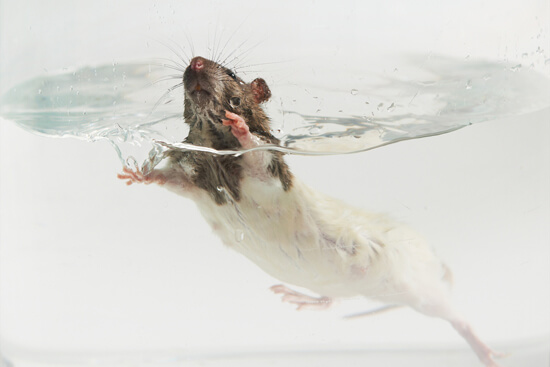Australian research body opposes particularly cruel animal experiments
- News
Is an end to the forced swim test in sight?
In December, the National Health and Medical Research Council (NHMRC) in Australia clearly opposed two particularly cruel and scientifically questionable animal experiments, which it will no longer support in the future. This stance could have far-reaching consequences and lead to a complete ban on the affected experiments in Australia. The German organization Doctors Against Animal Experiments (DAAE) welcomes this as a crucial step towards a more humane and human-focused research.
In Australia, the National Health and Medical Research Council (NHMRC) has released statements on two widely used animal testing procedures: According to these documents, the forced swim test is no longer permitted in projects funded by the NHMRC, and certain inhalation studies involving rodents are to be phased out as soon as possible (1).
The forced swim test is a procedure commonly used in depression research since the 1970s. In this test, mice or rats are placed in a container filled with water, where they cannot stand and have no means of escape. It is then observed how long the animals swim and attempt to escape before they give up and let themselves float on the water's surface. Animals giving up earlier are assumed to have “a lack of drive”, which is supposed to resemble depression-like symptoms. The test induces fear and despair in the animals (2). Furthermore, according to the NHMRC, there is a lack of evidence for the scientific validity of the procedure, which does not provide any insights into depression (3).
The second statement from the NHMRC pertains to specific inhalation experiments involving rodents (4). In these experiments, mice or rats are confined in narrow tubes where they cannot move, with only their noses protruding. Immobilized and unable to move, the animals are required to inhale harmful substances (such as tobacco smoke) through their noses for hours, typically on 5 days per week. In addition to the damage caused by the inhaled substances, the prolonged immobilization induces significant anxiety in the helpless animals. According to the NHMRC, the fears, stress, and pain caused by the test, “combined with the inherent limitations of animal models”, result in low transferability of the results to humans (4).
Both position papers are not solely based on ethical concerns due to the suffering of animals placed in desperate and life-threatening situations during the experiments. In its justifications, the NHMRC addresses significant scientific concerns about the validity of the tests. Consequently, the NHMRC will no longer fund projects that involve the forced swim test in the future, and existing projects must justify the continued use of the test (3). Regarding inhalation studies, the NHMRC concludes that they "must be phased out as soon as practicable." In new projects funded by the NHMRC, the procedure can only be used in exceptional cases, and for ongoing projects, the use of the procedure must be justified by mid-March (4).
The statements are likely to have far-reaching consequences, as the NHMRC is not only Australia's leading health and medical research funding body but also publishes the Australian code for the care and use of animals for scientific purposes (5), which has been incorporated into Australia's animal welfare laws.
"We have been pointing out for years that these experiments are not only cruel but also pointless, as their results cannot be transferred to humans (6). The fact that the Australian research body is vehemently opposing the conduct of these animal experiments, referring not only to ethical concerns but especially to the lack of scientific validity of the procedures, is something we explicitly welcome," says Dr. Johanna Walter, Scientific Advisor at Doctors Against Animal Experiments. "The forced swim test has already been discontinued by leading pharmaceutical companies such as Roche, AbbVie, and Pfizer (7). Not only because it is cruel but primarily because such tests are expensive and yield no benefits. Why the forced swim test is still allowed in the EU is completely incomprehensible," Walter continues.

The Forced Swim Test: Rats and mice are forced to swim to exhaustion to simulate depression-like behavior.
References
- Stock, P. Top medical research body says these two tests on mice and rats should end, Cosmos, 16.01.2024 >>
- Gericke, C. Pharmafirma Dr. Willmar Schwabe testet Lavendelöl in grausamem Tierversuch, Pressemitteilung von Ärzte gegen Tierversuche vom 18.07.2023 >>
- Statement on the forced swim test in rodent models, NHMRC, 13.12.2024 >>
- Statement on smoke inhalation procedures in rodent models, NHMRC, 13.12.2024 >>
- Australian code for the care and use of animals for scientific purposes >>
- Schwimmen bis zur Verzweiflung, Kampagne von Ärzte gegen Tierversuche, TASSO und Bund gegen den Missbrauch der Tiere (abgeschlossen) >>
- Dan, H. Progress! A new policy could eliminate the use of the forced swim test in Australia. News von PeTA Australia vom 14.12.2024 >>
